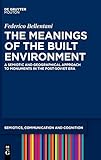The Meanings of the Built Environment : A Semiotic and Geographical Approach to Monuments in the Post-Soviet Era / Federico Bellentani.
Material type: TextSeries: Semiotics, Communication and Cognition [SCC] ; 24Publisher: Berlin ; Boston : De Gruyter Mouton, [2021]Copyright date: ©2021Description: 1 online resource (XIII, 188 p.)Content type:
TextSeries: Semiotics, Communication and Cognition [SCC] ; 24Publisher: Berlin ; Boston : De Gruyter Mouton, [2021]Copyright date: ©2021Description: 1 online resource (XIII, 188 p.)Content type: - 9783110614459
- 9783110614817
- 9783110617276
- Cultural geography -- Estonia
- Cultural geography -- Former Soviet republics
- Monuments -- Estonia
- Monuments -- Former Soviet republics
- Semiotics and architecture -- Estonia
- Semiotics and architecture -- Former Soviet republics
- LANGUAGE ARTS & DISCIPLINES / Linguistics / General
- Cultural Geography
- Monuments and Memorials
- Post-Soviet City
- Semiotics of Culture
- 725/.94094798 23
- NA9348.E75 B45 2021
- online - DeGruyter
- Issued also in print.
| Item type | Current library | Call number | URL | Status | Notes | Barcode | |
|---|---|---|---|---|---|---|---|
 eBook
eBook
|
Biblioteca "Angelicum" Pont. Univ. S.Tommaso d'Aquino Nuvola online | online - DeGruyter (Browse shelf(Opens below)) | Online access | Not for loan (Accesso limitato) | Accesso per gli utenti autorizzati / Access for authorized users | (dgr)9783110617276 |
Browsing Biblioteca "Angelicum" Pont. Univ. S.Tommaso d'Aquino shelves, Shelving location: Nuvola online Close shelf browser (Hides shelf browser)

|

|

|

|

|

|

|
||
| online - DeGruyter Plan Your Family - Plan Your Nation : Bevölkerungspolitik als internationales Entwicklungshandeln in Kenia (1932-1993) / | online - DeGruyter Stata : A Really Short Introduction / | online - DeGruyter Urheberrecht im Prozess : Urheberrechtliche Ansprüche und ihre Durchsetzung / | online - DeGruyter The Meanings of the Built Environment : A Semiotic and Geographical Approach to Monuments in the Post-Soviet Era / | online - DeGruyter Nicodemus Frischlin: Korrespondenz : Mit Regesten und Kommentar / | online - DeGruyter The Samaritans in Historical, Cultural and Linguistic Perspectives / | online - DeGruyter Die Rede vom Jüngsten Gericht in den Konfessionen der Frühen Neuzeit / |
Frontmatter -- Contents -- List of Figures -- List of Infographics -- 1 Connecting semiotics and cultural geography: A new approach to the study of monuments and memorials -- Part A: A Semiotic and geographical approach to monuments in transitional societies -- 2 Toward a semiotic and geographical approach to monuments -- 3 The multiple meanings of monuments in transitional societies: The case of Estonia -- 4 The cultural reinvention of monuments and memorials -- Part B: The cultural reinvention of monuments in Estonia -- 5 Removing and relocating the Bronze Soldier of Tallinn as a translation strategy -- 6 Erecting new politically-charged memorials: The War of Independence Victory Column -- 7 The coexistence of old and new: The memorial landscape of Maarjamäe -- 8 Erecting new urban decorations: The Kissing Students of Tartu -- Conclusions: Towards a semiotics of post-Soviet monuments -- List of references -- Index
restricted access online access with authorization star
http://purl.org/coar/access_right/c_16ec
This volume analyses the interpretation of the built environment by connecting analytical frames developed in the fields of semiotics and geography. It focuses on specific components of the built environment: monuments and memorials, as it is easily recognisable that they are erected to promote specific meanings in the public space. The volume concentrates on monuments and memorials in post-Soviet countries in Eastern Europe, with a focus on Estonia. Elites in post-Soviet countries have often used monuments to shape meanings reflecting the needs of post-Soviet culture and society. However, individuals can interpret monuments in ways that are different from those envisioned by their designers. In Estonia, the relocation and removal of Soviet monuments and the erection of new ones has often created political divisions and resulted in civil disorder. This book examines the potential gap between the designers’ expectations and the users’ interpretations of monuments and memorials. The main argument is that connecting semiotics and geography can provide an innovative framework to understand how monuments convey meanings and how these are variously interpreted at societal levels.
Issued also in print.
Mode of access: Internet via World Wide Web.
In English.
Description based on online resource; title from PDF title page (publisher's Web site, viewed 25. Jun 2024)


